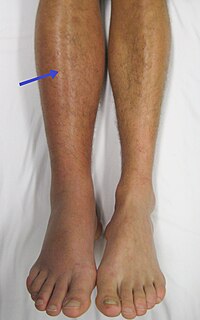
Photo from wikipedia
Hence, VTE is a major public health issue and public health agencies promote active research in VTE. However, despite major advances in the understanding of pathophysiology and treatment modalities, the… Click to show full abstract
Hence, VTE is a major public health issue and public health agencies promote active research in VTE. However, despite major advances in the understanding of pathophysiology and treatment modalities, the prognosis of VTE has not changed over the past 20 years and management remains challenging.1– 4 Anticoagulant therapy, the mainstay of VTE treatment, drastically reduces the risk of early VTE recurrence and death, but it exposes patients to a substantial risk of bleeding.3,4 In this setting, the main well defined and standardized outcomes addressed in treatment clinical trials during the 50 past years were recurrent VTE (nonfatal and fatal recurrences), bleeding (major and clinically relevant nonmajor bleeding), and mortality of all causes. Despite major improvement in antithrombotic management, the prognosis of patients with VTE remains poor in more than 50% of cases for the following reasons. First, at 3 to 6 months of anticoagulant therapy, 30% of patients will have developed chronic and irreversible sequelae due to incomplete thrombus resolution, which are associated with impaired quality of life and a potential increased mortality: at least one quarter of patients will develop chronic thromboembolic disease and approximately 4% (incident and prevalent) chronic thromboembolic pulmonary hypertension after PE, while patients after a DVT face a 30% risk of postthrombotic syndrome.3– 5 In addition to these major issues, there is growing evidence that more than one third will develop posttraumatic stress syndrome or even depression.6– 9 Second, VTE was historically mainly considered an acute condition, for which 3 months of anticoagulation was proposed for the majority of patients, but in the past 20 years this paradigm has changed: VTE is now more often recognized as a chronic disease (or condition, with genetic or associated acquired risk factors) in a high proportion of patients rather than an acute isolated phenomenon. In more than 50% of cases, patients not only have chronic sequelae but they have an increased risk of recurrent VTE, persisting over the lifetime.3,4,10,11 In patients with unprovoked VTE (no clinical circumstances), if anticoagulation is stopped beyond the initial 3 to 6 months of treatment, more than one third will develop recurrent VTE, with an almost unchanged case fatality rate reaching up to 10% when recurrence occurred as PE.10,11 As a consequence, international guidelines recommend treating patients with a first episode of unprovoked VTE “indefinitely.”3,4 However, such practice exposes patients to a substantial linear increase in the risk of bleeding (up to 10% per year risk of relevant bleeding during the first years of followup, with a case fatality rate of 10% to 20% for major bleeding12 that could ultimately exceed the risk of recurrent VTE). Furthermore, proposing indefinite anticoagulation in all patients with unprovoked VTE exposes two thirds of patients to an unjustified risk of bleeding, because they would never have developed recurrent VTE if anticoagulation had been stopped. In this context, personalized medicine remains a major objective to propose the most effective and the least harmful treatment for an individual patient. In addition to new treatments, the discovery of more accurate, discriminant, and timedependent biomarkers, based on a variety of “omics” and enhanced mathematical models, is a key but not sufficient issue. Indeed, guidelines of anticoagulant management after unprovoked VTE recommend only a binary choice: either stopping treatment at
Journal Title: Journal of Thrombosis and Haemostasis
Year Published: 2022
Link to full text (if available)
Share on Social Media: Sign Up to like & get
recommendations!